A calico cat is instantly recognizable due to their blend of three colors on their coat. Those three colors can be almost a rainbow, including shades of brown, orange, white or cream, black, or even bluish gray. There is no single "calico pattern," as the combination of colors can be mottled, patchy, or spotted.
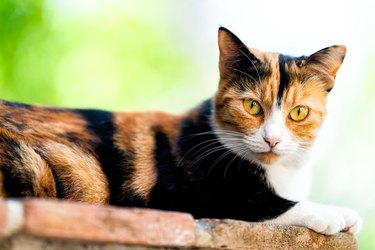
Video of the Day
There are many things that make calico cats unique besides their intriguing coat colors. Let's explore a few of them.
Video of the Day
1. Calico is not a breed.
While the calico coloration on a cat can be very unique, it is not unique or predictable enough for a calico cat to qualify as a recognized breed. The Cat Fanciers Association's list of breeds lists some breeds that have coats similar to a calico pattern, including the American shorthair, Japanese bobtail, American curl, Bengal, and Persian, but none of them are quite the same.
2. The name "calico" means a type of cloth.
According to Etymology Online, the word calico is an old word referring to a type of cloth from Calicut, a seaport on the coast of India. The calico pattern originally meant a dappled pattern on printed cloth, but in the early 1800s began to refer to the dappled coat of horses, and in the late 1800s, cats.
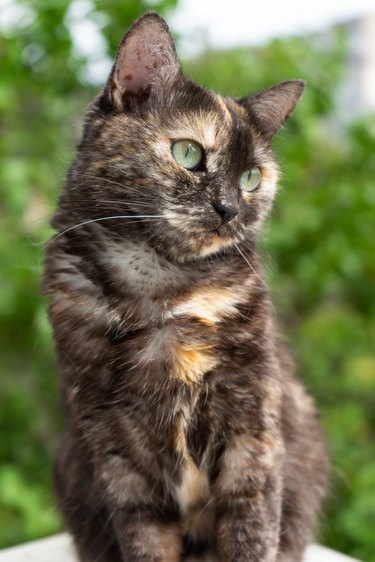
3. Calico coloration and tortoiseshell are different.
Many people think that calico cats and tortoiseshell cats are the same thing, but they aren't. According to BasePaws, tortoiseshell cats boast mottled patches of orange, cream, and brown on a base that is predominantly black. Calico cats have a base that is predominantly white. Rather than mottled, calico patterns are typically larger patches. All calico cats are tortoiseshell, but not all tortoiseshell cats are calico.
4. Most calico cats are female.
Calico coloration is the result of complicated sex chromosomes. Most calico cats are female, because males carry only one copy of the X chromosome while female cats carry two copies of the X chromosome in their cells. Meowingtons had an easy to understand explanation of this, which is that a cat needs two X chromosomes to develop the calico pattern. If a cat has an XX pair of chromosomes, it will be female. Male cats have an XY chromosome pair, so they can rarely be calicos.
5. Male calico cats are almost always sterile.
There's less than a 0.1 percent chance of a calico cat being born male, which works out to only approximately one in 3,000 male calicos. If a calico cat is male, that means they must have an extra X chromosome, making it XXY. This also means that extra X makes them suffer from some serious health issues that makes them sterile (unable to reproduce offspring)
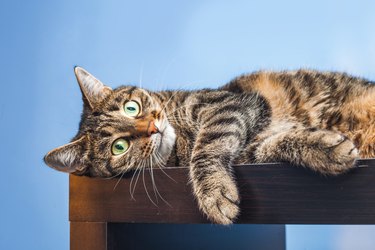
6. Calico colors have their own names.
According to Catalogical, the various patterns of calicos are called by different names. Calicos where the colors are muted are sometimes called calimanco, clouded tigers, or dilute calicos. Rather than bright orange and black and brown, these calicos may be more often cream, smokey grey, or gold.
A caliby is a shorthand version referring to "calico tabby cats," which are multicolored cats with mottled fur. Tabbies themselves have many color names. According to BasePaws, there are four types of tabbies. Mackerel tabbies have vertical stripes on the sides. This is the most common tabby pattern. Classic tabbies have swirled patterns on their sides. Ticked tabbies have bands of color, whereas spotted tabbies have spots. smaller or larger spots.
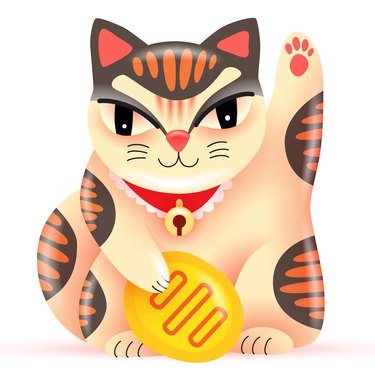
7. Calico cats bring good luck.
In Japan, lucky cat figurines are called maneki neko. They are often depicted as calico cats holding up one paw. They represent good fortune or good health. According to Live Japan, if a maneki neko is a solid color, that has a specific meaning. For instance, gold represents wealth and prosperity, and red represents marriage and love.
8. A calico cat named Tama is a Shinto deity
In 2015, a calico cat named Tama died, and she was mourned by people all over Japan. She became the unofficial "stationmaster" in 2007 after continuing to hang out at a train station in rural Wakayama prefecture in western Japan. Tama even had a uniform, complete with a stationmaster's hat, and she was paid in cat food. People bought tickets to the train station to visit her.
The World reports that Tama has been declared a Shinto deity. She was laid to rest at a shrine for cats near the station. The Wakayama station now has another stationmaster, a 5-year-old calico named Nitama.
9. Calico cats were symbols of protection for Japanese fishermen.
Certa Pet says Japanese fishermen would keep calico cats on their ships to protect them from storms and the ghosts of their envious ancestors.
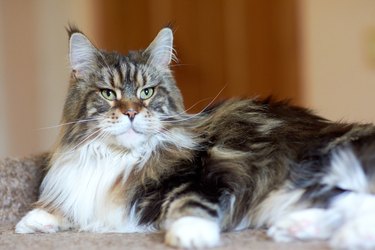
10. Calico cats have cattitude.
It's true. People say that their calico cats are more feisty or otherwise have quirky personalities. A 2015 survey of 1,200 cat owners done by veterinarians from UC Davis (as reported by the Sacramento Bee) confirmed that cats with tortoiseshell and calico coloration are more "challenging." The cat owners reported that calicos and torties are more likely to hiss, chase, bite, swat, or scratch their humans.
- Cat Fanciers Association: Breeds
- Etymology Online: Calico
- BasePaws: Cat Coat Genetics
- Meowingtons: Here's Why Calico Cats Are the Coolest
- Catalogical: Facts About Calico Cats | What You Need To Know About These Kitties (+ A Guide On How To Care For A Calico Kitten)
- Live Japan: Tokyo Station:Overview & History
- The World: A New Stationmaster Cat Has Been Selected After the Passing of a Much Loved Calico in Japan
- Certa Pet: Calico Cats: The Magic and Beauty of the Calico
- Sacramento Bee: UC Davis Study: Calico, Tortoiseshell Female Cats Often Most Challenging